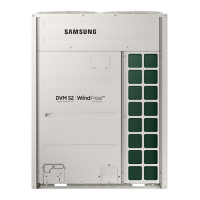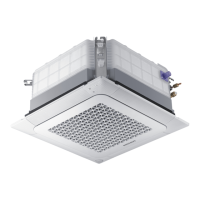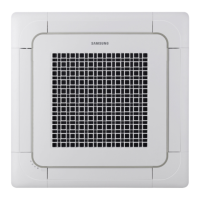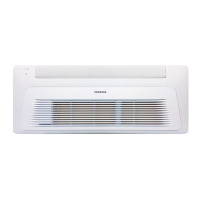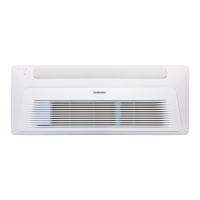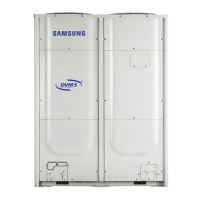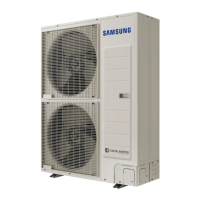Why does my Samsung AM TNVD not operate immediately after restarting?
- SStephanie JonesSep 9, 2025
Your Samsung Air Conditioner will start in 3 minutes due to a protective mechanism.

Why does my Samsung AM TNVD not operate immediately after restarting?
Your Samsung Air Conditioner will start in 3 minutes due to a protective mechanism.
Why do odours permeate the room when my Samsung AM TNVD is on?
If odors are present while your Samsung Air Conditioner is running, consider that the appliance may be running in a smoky area or that smell is entering from the outside. To resolve this, operate the air conditioner in Fan mode or open the windows to air out the room.
Why do odors permeate in the room during Samsung Air Conditioner operation?
If you notice odors permeating in the room when your Samsung Air Conditioner is running, it could be due to the appliance operating in a smoky area or a smell entering from outside. Try operating the air conditioner in Fan mode or open the windows to air out the room.
Why doesn't my Samsung Air Conditioner operate immediately after restarting?
If your Samsung Air Conditioner doesn't start immediately after restarting, it's due to a protective mechanism that prevents overloading. The air conditioner will start in 3 minutes.
Why does my Samsung Air Conditioner make a bubbling sound?
If your Samsung Air Conditioner is making a bubbling sound, it's because the refrigerant is circulating through the compressor. Let the air conditioner operate in the selected mode.
| Brand | Samsung |
|---|---|
| Model | AM TNVD Series |
| Category | Air Conditioner |
| Language | English |
Read and follow all safety information and instructions before installation, use, or maintenance.
Explains the meaning of warning, caution, important, and note symbols used in the manual.
Safety precautions for general use, including restrictions for children and people with reduced capabilities.
Notes that the product has been treated with Silver zinc zeolite for antimicrobial function.
Warnings about using the correct power line and avoiding extension lines or transformers.
Emphasizes that installation must be performed by a qualified technician or service company.
Warns against installing the outdoor unit in high external walls where it could fall.
Instructions for proper grounding and drain hose installation to prevent issues.
Advises against installing the unit in locations requiring precise temperature control like server rooms.
Safety warnings regarding circuit breaker damage and proper power line handling.
Instructions for handling appliance floods, strange noises, smells, or smoke.
Procedures for gas leaks and safety advice for reinstalling the unit.
Warnings about touching circuit breakers with wet hands and keeping packaging from children.
Cautions against touching the front panel during heating and inserting fingers into air inlets.
Warning against striking or pulling the unit with excessive force.
Advises against children climbing outdoor units and using the unit in poorly ventilated areas.
Instructions for water entry and prohibition of self-repair, disassembly, or modification.
Caution against placing objects under the indoor unit due to water dripping.
Recommendation to check the outdoor unit installation frame annually for safety.
Instruction to stop fan movement before manually adjusting airflow blades to prevent injury.
Warning against vehicle installation and placing objects on the appliance.
Warnings against operating with wet hands and spraying insecticides onto the appliance.
Warning against drinking air conditioner water and mishandling the remote control.
Safety advice for battery replacement and avoiding contact with product pipes.
Warning against using the unit for unintended purposes and direct airflow exposure.
Warnings against spraying water directly and using specific cleaning agents.
Cautions regarding sharp edges on heat exchangers and advising against self-cleaning the interior.
Identifies key components of the indoor unit, including airflow blades and sensors.
Explains the meaning of various indicators on the unit's display panel.
Identifies key components of the indoor unit, including airflow blades and sensors.
Explains the meaning of various indicators on the unit's display panel.
Step-by-step instructions for cleaning the exterior surfaces of the indoor unit.
Safety warnings and cautions related to water spraying and chemical usage during cleaning.
Detailed instructions for cleaning the air filter and resetting the cleaning reminder.
Cautions to avoid damaging the filter during cleaning and drying processes.
Step-by-step guide for removing, cleaning, and reattaching the WindFree panel.
Caution about proper reattachment of the WindFree panel to avoid obstruction issues.
A chart outlining monthly, quarterly, and annual maintenance checks for indoor and outdoor units.
Notes on the importance of maintenance and factors affecting its frequency.
Details internal protection mechanisms like against cold air, de-ice cycle, and compressor protection.
Explains the de-ice cycle operation and notes on fan behavior during this cycle.
Explains the delay in operation due to protective mechanisms.
Provides checks for power connection, circuit breaker, power failure, and fuses.
Suggests checking fan mode and adjusting temperature settings.
Advises checking temperature settings, air filter, and initial operation time.
Explains fan speed adjustment in Auto/Dry modes.
Guides on setting the timer function using the remote control.
Suggests checking for smoky areas or external smells and using Fan mode or ventilation.
Explains bubbling sound during refrigerant circulation and recommends normal operation.
Explains condensation due to prolonged cooling with downward airflow.
Lists checks for battery depletion, installation, sensor blockage, and lighting interference.
Specifies indoor/outdoor temperature and humidity ranges for cooling.
Specifies indoor/outdoor temperature and humidity ranges for heating.
Specifies indoor/outdoor temperature and humidity ranges for drying.
Notes on heating temperature limits and cooling capacity reduction at high indoor temperatures.
Lists model numbers and their corresponding climate classes (T1, T3).
Details rated voltage, frequency, current, and power input for cooling/heating.
Provides the Energy Efficiency Ratio (EER) for cooling and heating operations.
Lists net weight, dimensions, and country of origin for the units.



